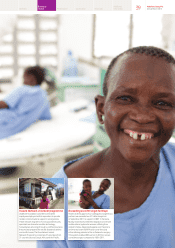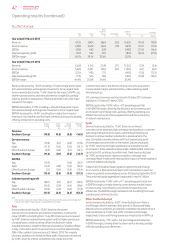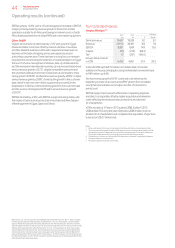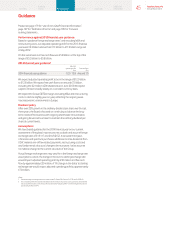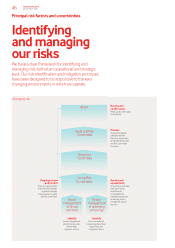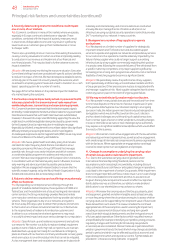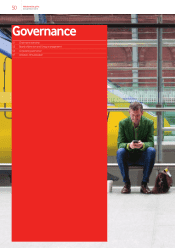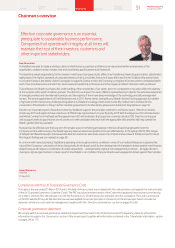Vodafone 2013 Annual Report Download - page 50
Download and view the complete annual report
Please find page 50 of the 2013 Vodafone annual report below. You can navigate through the pages in the report by either clicking on the pages listed below, or by using the keyword search tool below to find specific information within the annual report.
6. Severely deteriorating economic conditions could impact
one or more of our markets.
Risk: Economic conditions in many of the markets where we operate,
especially in Europe, continue to deteriorate or stagnate. These
conditions, combined with the impact of austerity measures, result
in lower levels of disposable income and may result in signicantly
lower revenue as customers give up their mobile devices or move
to cheaper tariffs.
There is also a possibility of one or more countries exiting the eurozone,
causing currency devaluation in certain countries and possibly leading
to a reduction in our revenue and impairment of our nancial and
non-nancial assets. This may also lead to further adverse economic
impacts elsewhere.
Mitigation: We are closely monitoring the eurozone situation. Executive
Committee briengs have been provided with specic actions identied
to reduce the impact of the risk. We have developed a detailed business
continuity plan in the event of a country leaving the eurozone, which
could lead to a banking system freeze and a need to transition to a “cash
based” operating system for a number of months.
See page 49 for further details on the potential impact for Vodafone
of a market leaving the eurozone.
7. Our business may be impacted by actual or perceived health
risks associated with the transmission of radio waves from
mobile telephones, transmitters and associated equipment.
Risk: Concerns have been expressed that the electromagnetic signals
emitted by mobile telephone handsets and base stations may pose health
risks. We are not aware that such health risks have been substantiated,
however, in the event of a major scientific finding supporting this view this
might result in prohibitive legislation being introduced by governments
(or the European Union), a major reduction in mobile phone usage
(especially by children), a requirement to move base station sites, significant
difficulty renewing or acquiring site leases, and/or major litigation.
An inadequate response to electromagnetic fields (‘EMF’) issues may result
in loss of confidence in the industry and Vodafone.
Mitigation: We have a global health and safety policy that includes
standards for radio frequency elds that are mandated in all our
operating companies. We have a Group EMF board that manages
potential risks through cross sector initiatives and which oversees
a coordinated global programme to address and reduce public
concern. We have close engagement with European Union institutions,
in coordination with an international policy team in Brussels, to ensure
early warning and advocacy related to possible precautionary
legislation. We are engaged with relevant bodies to ensure that the
scientic research agenda set by the World Health Organization is fully
funded and executed as fast as reasonably possible.
8. Failure to deliver enterprise service offerings may adversely
affect our business.
Risk: By expanding our enterprise service offerings through the
growth of Vodafone Global Enterprise, the acquisitions of CWW and
TelstraClear, and the establishment of cloud, hosting and international
carrier services, the Group increasingly provides xed and mobile
communication services to organisations that may provide vital national
services. These organisations rely on our networks and systems
24hours a day, 365 days a year to deliver their products and services
to their customers. A failure to build and maintain our infrastructure
to the required levels of resilience for enterprise customers and
to deliver to our contracted service level agreements may result
in a costly business impact and cause serious damage to our reputation.
Mitigation: Specic back-up and resilience requirements are built into
our networks. We monitor our ability to replace strategic equipment
quickly in event of failure, and for high risk components, we maintain
dedicated back-up equipment ready for use. Network contingency
plans are linked with our business continuity and disaster recovery plans
which are in place to cover the residual risks that cannot be mitigated.
A crisis management team and escalation processes are in place both
nationally and internationally, and crisis simulations are conducted
annually. We also manage the risk of malicious attacks on our
infrastructure using our global security operations centre that provides
24/7 monitoring of our network in many countries.
9. We depend on a number of key suppliers to operate
our business.
Risk: We depend on a limited number of suppliers for strategically
important network and IT infrastructure and associated support
services to operate and upgrade our networks and provide key services
to our customers. Our operations could be adversely impacted by the
failure of a key supplier who could no longer support our existing
infrastructure, by a key supplier commercially exploiting their position
in a product area following the corporate failures of/the withdrawal from
a specic market by competitors, or by major suppliers signicantly
increasing prices on long-term programmes where the cost or technical
feasibility of switching supplier becomes a signicant barrier.
Mitigation: We periodically review the performance of key suppliers,
both operationally and nancially, across individual markets and from
a Group perspective. Other processes are in place to regularly identify
and manage “suppliers at risk.” Most supplier categories have business
continuity plans in place in the event of single supplier failure.
10. We may not satisfactorily resolve major tax disputes.
Risk: We operate in many jurisdictions around the world and from time
to time have disputes on the amount of tax due. In particular, in spite
of the positive India Supreme Court decision relating to an ongoing
tax case in India, the Indian government has introduced retrospective
tax legislation which would in effect overturn the court’s decision
and has raised challenges around the pricing of capital transactions.
Such or similar types of action in other jurisdictions, including changes
in local or international tax rules or new challenges by tax authorities,
may expose us to signicant additional tax liabilities which would affect
the results of the business.
Mitigation: We maintain constructive engagement with the tax authorities
and relevant government representatives, as well as active engagement
with a wide range of international companies and business organisations
with similar issues. Where appropriate we engage advisors and legal
counsel to obtain opinions on tax legislation and principles.
11. Changes in assumptions underlying the carrying value
of certain Group assets could result in impairment.
Risk: Due to the substantial carrying value of goodwill under
International Financial Reporting Standards, revisions to the
assumptions used in assessing its recoverability, including discount
rates, estimated future cash ows or anticipated changes in operations,
could lead to the impairment of certain Group assets. While impairment
does not impact reported cash ows, it does result in a non-cash charge
in the consolidated income statement and thus no assurance can
be given that any future impairments would not affect our reported
distributable reserves and, therefore, our ability to make dividend
distributions to our shareholders or repurchase our shares.
Mitigation: We review the carrying value of the Group’s property, plant
and equipment, goodwill and other intangible assets at least annually,
or more frequently where the circumstances require, to assess whether
carrying values can be supported by the net present value of future cash
ows derived from such assets. This review considers the continued
appropriateness of the assumptions used in assessing for impairment,
including an assessment of discount rates and long-term growth
rates, future technological developments, and the timing and amount
of future capital expenditure. Other factors which may affect revenue
and protability (for example intensifying competition, pricing pressures,
regulatory changes and the timing for introducing new products
or services) are also considered. Discount rates are in part derived from
yields on government bonds, the level of which may change substantially
period to period and which may be affected by political, economic and
legal developments which are beyond our control. Further details are
provided in “Critical accounting estimates” on page 87.
Principal risk factors and uncertainties (continued)
48 Vodafone Group Plc
Annual Report 2013



